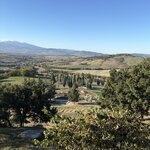Seasonal Planning for Italy Travel
From the snowy Alps and the romantic canals of Venice to white-sand beaches and world-class wine regions, Italy has it all. Thanks to the sheer diversity of its landscapes, it's a wonderful destination at any time of year.
Generally speaking, summer brings very warm temperatures—especially in the south—along with plenty of sightseers in pursuit of sun, sand, and la dolce vita. If you're looking to hit the coast, you're better off visiting in the late spring, early summer, or September, when temperatures are warm but crowds are smaller. Fall brings moderate temperatures, making it a pleasant time to explore cities like Rome and Florence. In the northern part of the country, autumn also brings gorgeous foliage to the picture-perfect hills and vineyards of Tuscany and Piedmont.
In the colder months of the year, skiers and snowboarders head to the excellent ski resorts in the north. Elsewhere in the country, you'll have relative peace and quiet at museums, theaters, and cultural attractions, as fewer international visitors are in town. Spring is a wonderful time to visit, too: flowers are in bloom around the Italian Lakes, and all along the coastlines, towns and villages start awakening from their winter sleep.
Check out these tours and itineraries for ideas on planning a trip to Italy.
| Seasons | Pros | Cons | Best for | Where to Visit |
| Spring (Mar-May) |
Cold weather dissipates, longer daylight hours, Easter celebrations |
Crowding around holidays (Carnivale, Easter, Holy Week) |
Blossoming flowers, cultural celebrations, city exploration, outdoor pursuits: winter sports (March); whitewater rafting, hiking, mountain biking, etc (late spring) |
Dolomites and Alps (for skiing), Amalfi Coast, Cinque Terre, Trentino Alto Adige, Florence, Rome, Venice, Sicily, Matera |
| Summer (Jun-Aug) | Great beach weather, long hours of daylight, extended hours at main attractions | Heat can be overbearing; crowded along the coasts (Italians take their August vacations) | Beach holiday, water sports, outdoor excursions in the mountains (where it's cooler) | Sardinia, Puglia, Alps, Dolomites, South Tyrol, Umbria, Cilento National Park for quieter beaches |
| Fall (Sep-Nov) | Cooler weather, cheaper prices, and fewer crowds than in summer; changing fall foliage | Coastal resorts shutter (typically end of October) | City exploration, visiting popular sites, sampling regional delicacies (white truffles) | Florence, Rome, Venice; Alba (for truffles), Milan, Turin |
| Winter (Dec-Feb) | Off-season deals, Christmas festivities, fewer foreign travelers, fresh powder | Limited opening hours at some attractions; many resorts and beach sites close | Christmas markets, winter sports (skiing, snowboarding, sledding, skating), Carnevale | Valle d'Aosta, Lombardy, and Trentino Alto Adige (for winter sports/ après-ski activities); Bolzano, Trento, and Rovereto (for winter fairs), Venice (for Carnevale) |
Spring in Italy (March to May)

Many travelers agree that spring is the best time to visit Italy. Around the Italian Lakes, flowers are in bloom, with azaleas, rhododendrons, and magnolias tumbling down the gardens of grand lakefront villas. In April, hotels along the coast start opening their doors again. By May, temperatures are particularly agreeable, making it ideal to sightsee and enjoy outdoor activities. Wondering where to go and what to see in Italy? This 14-day tour touches all of the country's top highlights.
Destinations you might consider visiting in spring include the Amalfi Coast and Cinque Terre, which are both relatively quiet before the crowds descend for the summer. Up in the Alps and in the Dolomites, waterfalls have started melting, and there are excellent whitewater rafting opportunities, as well as hiking and mountain biking. Spring is also the perfect time to visit Trentino Alto Adige's spectacular mountain lakes; they're breathtakingly beautiful at this time of year, with crystal-clear emerald waters surrounded by jagged peaks.
Events in Spring
Carnevale, Nationwide. Italy's version of the Carnival celebration of Lent changes months depending on the liturgical calendar, but occasionally occurs in March. it's the biggest event in the country, with parades and parties in cities and towns throughout, some of which last for weeks.
Easter/ Holy Week, Nationwide. Because Easter follows the liturgical calendar, it doesn't fall on the same day each year. Sometimes it doesn't even occur in April. That said, it typically does fall in this month, and celebrations and processions occur throughout the nation.
Giro d'Italia, Numerous cities (May). Italy's answer to the Tour de France lasts three weeks in May (precise dates change yearly). Even if you don't have much interest in witnessing a cycling race, you should still check the schedule. The route passes through many cities and towns throughout the country, and most lodging options in these locales will be fully booked during this time.
Learn More
Italy in March
Italy in April
Italy in May
Chat with a local specialist who can help organize your trip.
Summer in Italy (June to August)

With over 4,500 miles of coastline, Italy has a lot of beautiful beaches. In summer, Italians and foreign visitors flock to the seaside in droves. Note that temps around the country soar in July and August: it's stiflingly hot in cities like Turin and Milan, and local residents seek respite from the heat along the coast, heading to the beaches of nearby Liguria. Try to avoid visiting in August, when many Italians plan their holidays. You'll be better off planning your beach stay early or late in the summer season. Even then, you'll have to plan ahead. Hotels fill up fast along the coast, where scores of beach umbrellas and serried sunbeds line the sand.
If you're after more rugged stretches of coastline, head to Sardinia, home to gorgeous white-sand beaches dotted with beguiling coves. With lovely azure waters, Puglia is a popular summer destination with a number of traditional villages where you can spend the night and dine on freshly caught seafood.
Prefer the mountains to the beach? In summer, outdoor enthusiasts thoroughly enjoy hiking in the Alps and the Dolomites, both home to spectacular mountain scenery and superb treks to suit all levels. Temperatures up in the mountains are pleasant, too, with hot sunny days and cool nights.
Events in Summer
Republic Day, Nationwide (June 2). This national holiday commemorates the day in 1946 when the nation voted to switch from a monarchy to a republic. Many businesses are closed, and there are celebrations, parades, and fireworks throughout the country, particularly in Rome.
Palio di Siena, Siena (July 2). This horse race is held each year on July 2 (and again on August 16) in Siena, Tuscany. It involves four days of horse racing and events in the city square, as well as much celebration by the huge audience.
Arena di Verona Opera Festival, Verona (June to September). Throughout the summer, you'll find nightly opera performances at the largest such venue in the world: Verona's ancient Roman Arena.
Learn More
Italy in June
Italy in July
Italy in August
Fall in Italy (September to November)

The fall is an ideal time to visit Italy. Temperatures have cooled down after summer, and major tourist destinations such as Florence, Rome, and Venice have partly emptied of international travelers, making them easier to visit. In the rolling hills of Tuscany, fiery reds, yellows, and oranges create hillsides of dazzling colors, with charming villages surrounded by the colors of autumn. In the south of the country, temperatures are still warm, making it a great time to sightsee and to enjoy a quiet swim in the sea. (Note that coastal resorts often close for the winter around the end of October.)
In October, with some advance planning, cyclists can take part in the famed L'Eroica vintage cycling event in the province of Siena. For more information on the event, take a look at this article. Travelers interested in cuisine shouldn't miss a trip to the White Truffle Fair in Piedmont. It's a rare chance to sample the regional specialty paired with the area's excellent Barolo and Barbaresco wines.
Events in Fall
Festa della Rificolona, Florence (September 6-7). Florence celebrates the birthday of the Virgin Mary (Christian tradition places it on September 8) with the Florence Paper Lantern Festival. Religious services are held, and locals and visitors fill the streets carrying paper lanterns. There's also a huge farmers' market in the main square featuring much organic produce.
Fiera Internazionale del Tartufo Bianco d'Alba, Alba (October). Throughout most of October, Alba hosts this International White Truffle Fair, celebrating one of Italy's most sought-after bits of produce: the white truffle.
Rome Jazz Festival (November). During the first two to three weeks of November, the jazz festival features a week of concerts and performances at select venues.
Learn More
Italy in September
Italy in October
Italy in November
Winter in Italy (December to February)

Fringed by the Alps and the Dolomites in the north, Italy offers superb skiing. Up in the Western Alps, Valle d'Aosta is home to the iconic Matterhorn and Mont Blanc, Europe's highest peak. It's one of the best destinations for winter sports on the entire continent. Neighboring Piedmont also offers excellent skiing, along with Lombardy and Trentino Alto Adige, home to the jagged Dolomites.
There's plenty for non-skiers, too, including ice skating and sledding. Scattered throughout these mountainous areas, charming Alpine villages are a joy to walk around: you'll find family-run shops selling local produce and welcoming restaurants where you can taste local specialties. If you're after some holiday festivity, don't miss the many Christmas markets that take place around the country. The markets in Trentino Alto Adige are particularly appealing: the towns of Bolzano, Trento, and Rovereto host winter fairs.
Events in Winter
Feast of the Immaculate Conception, Nationwide (December 8). Italians celebrate the Immaculate Conception of the Virgin Mary each year. Of course, this is a national holiday, meaning all public offices and many businesses are closed. Special masses are held in churches, and in Rome, there's a celebration in which the Pope lays a floral wreath on the Madonna statue at Piazza Mignanelli.
La Festa dell'Epifania, Nationwide (January 6). The Italian Christmas season is similar to that of other Western nations in many ways (including celebrating Christmas Eve and Christmas Day), but one aspect in which it is different is Epiphany. La Festa dell'Epifania marks the end of Italy's "12 days of Christmas." Children get excited as this is when an old witch called La Befana leaves gifts in their stockings.
Saint Agatha's Feast Day, Catania (February 5). Locals in Catania, Sicily, spend two days celebrating Saint Agatha, a martyr who died in the third century. A procession follows a silver carriage housing her relics up Monte Sangiuliano, and there's quite a bit of merrymaking and fireworks. The event is regarded as one of the largest religious processions in the world.






